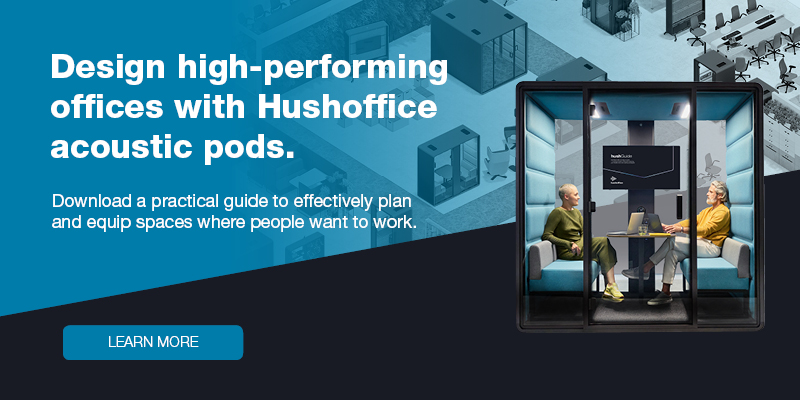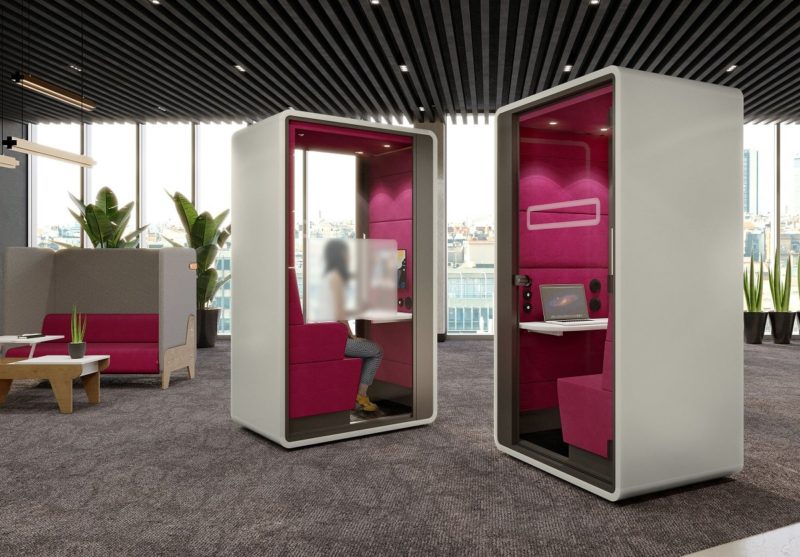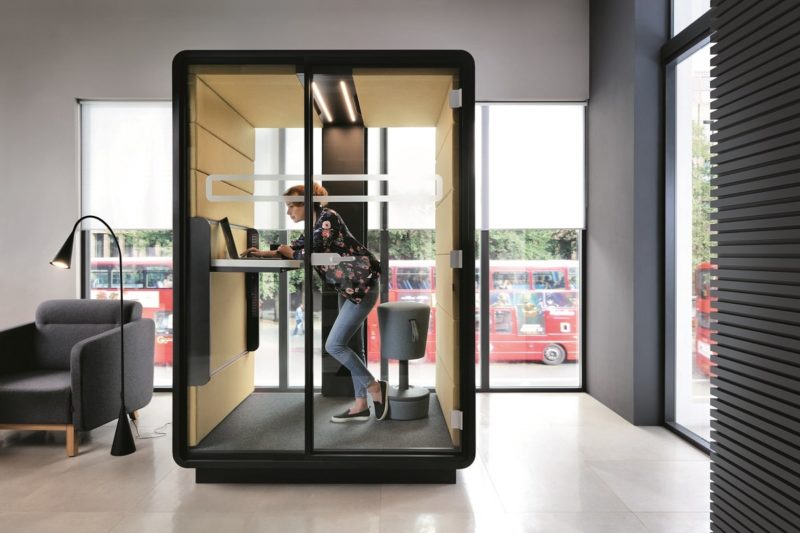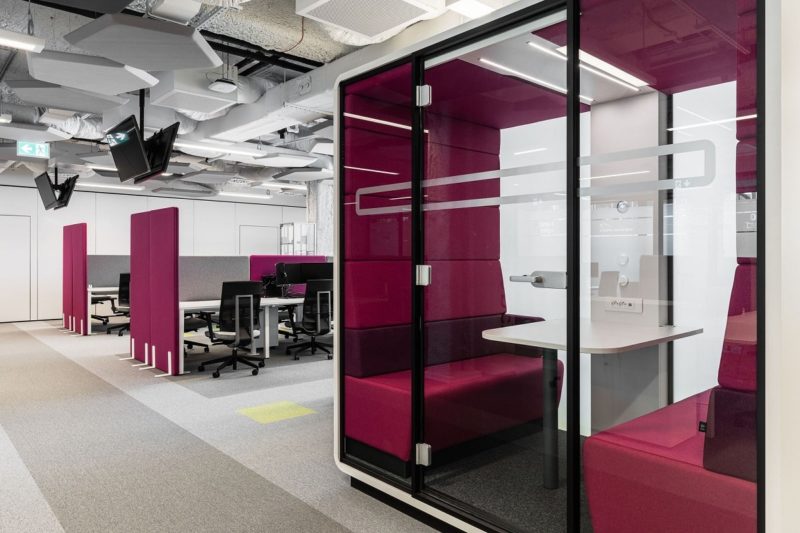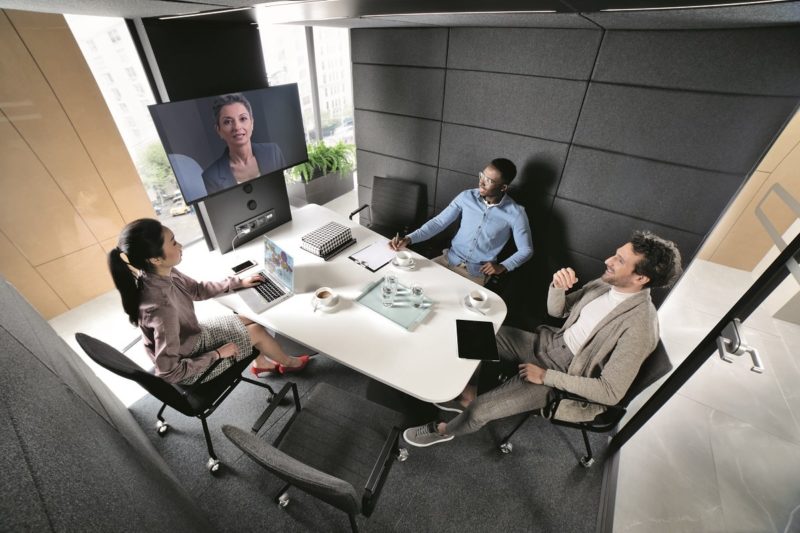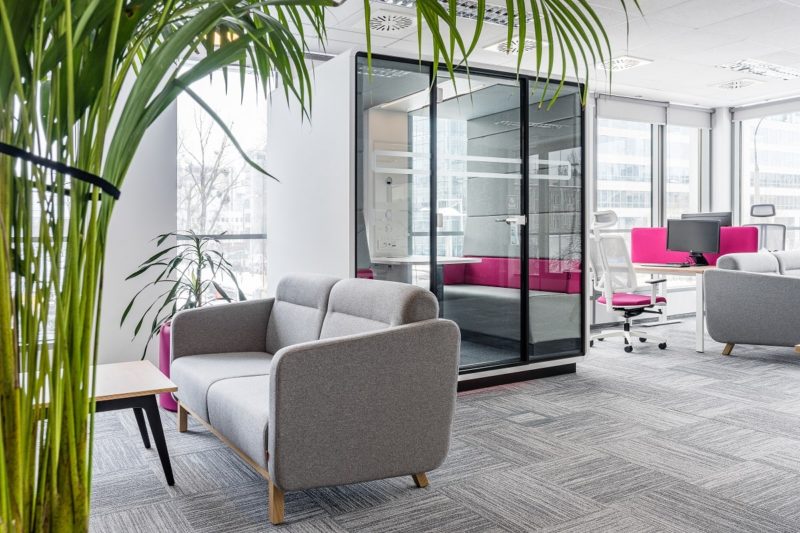AI will change the workplace. Here is how.
- Posted on: 4 June 2024
- By: Hushoffice Team
What does an AI-powered workplace look like? For architects, designers, employees, and facilities managers, AI’s influence will be perceived a little differently. Let’s dive in.
AI in the workplace – tl;dr
AI is indeed transforming the office design process for architects and designers. It is automating routine tasks. It is offering data-driven insights. And it enables predictive analytics for future trends. It can also be integrated with VR and AR for more immersive design visualization.
For facilities managers, AI’s influence is all about processing data. It will be able to optimize space utilization through the continuous monitoring of occupancy and usage patterns. Properly deployed, AI can also improve energy management by analyzing and adjusting for consumption patterns. Flexible furnishing like mobile pods will be helpful in allowing FMs to make full use of AI’s clear space optimization tips, moment to moment.
The employees’ main touchpoint with AI will be video meetings. For starters, the tech can provide real-time transcriptions and translations. It can improve audio and video quality. And it can gauge participant engagement via facial recognition. Because video meetings are critical in a hybrid world, video call booths like hushHybrid will become standard, allowing for a team to fully leverage AI’s potential to drive human connection moving forward.

Ironically, AI may unleash the most human-centric approach to the office’s design yet. Traditionally, space planning focuses strictly on maximizing efficiency and minimizing costs. Sometimes this balancing happens at the very expense of employee needs. But with a proper application of the right AI-based tools, designers can create office spaces that are more fine-tuned to the unique requirements and preferences of the people who work in them. AI’s superpower is its ability to analyze vast amounts of data. In the design process, this data is related to how employees use office spaces, their likes and dislikes, work habits, and even physiological responses to different environments. More effective work environments will be inevitable
– says Mateusz Barczyk, Senior Brand Manager, Hushoffice.
Better space planning, optimization, and efficiency with AI.
AI’s data collection and integration capabilities can give a much greater depth of knowledge around how spaces are used. It offers the ability to utilize both qualitative and quantitative data in developing a more well-rounded view of the office. For designers, this insight is gold.
Data is king. AI leverages data brilliantly.
Companies will more and more be leveraging the increased data-analysis capacity of AI to predict their space’s needs, adapting available furniture per changing work patterns. This means that the office will be more quickly responsive to emerging employee needs.
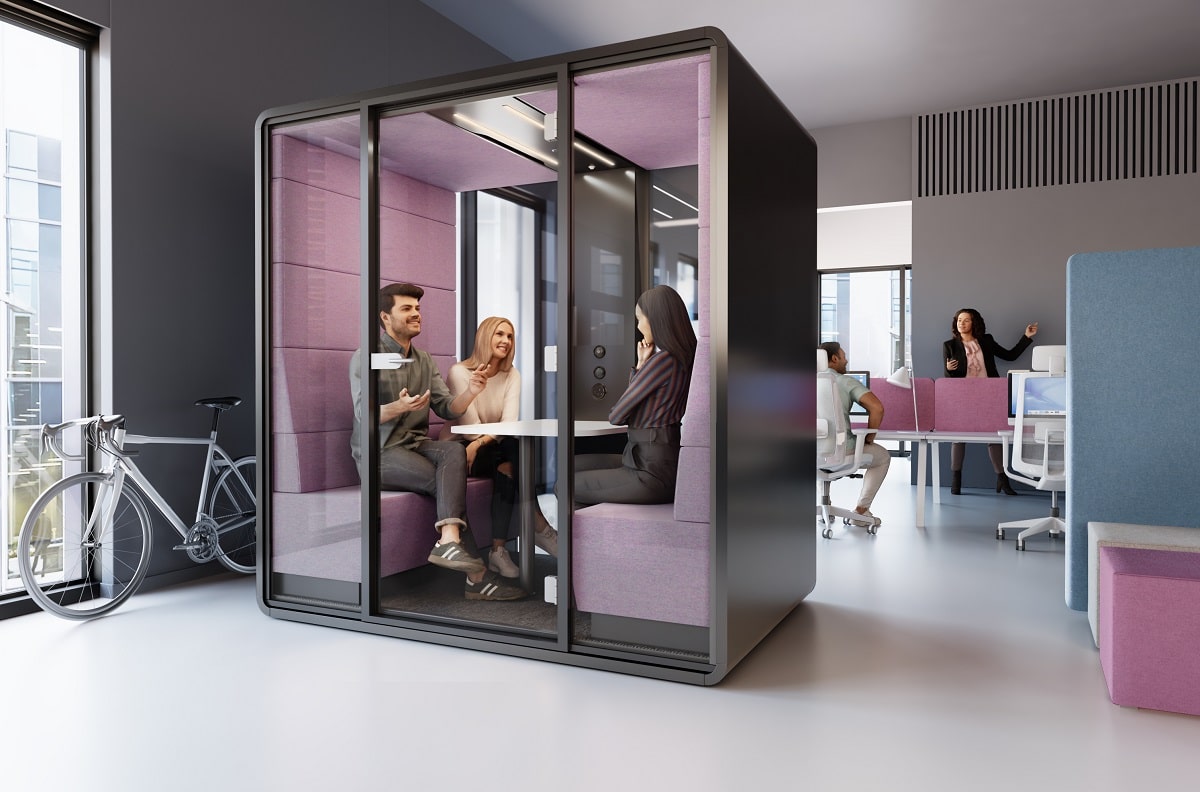
AI can make picking the best possible floorplate and space plan an easier task.
The best office for a hybrid team is one that connects people. But optimizing any floor plate large or small is a challenge – navigating the nuances of drawing up and evaluating multiple options within tight timeframes and budgetary constraints is no small feat. AI can help.
When there is too much information, AI makes sense of it all.
As one of many examples, occupancy tracking systems gather incredible amounts of data, which can be overwhelming. AI can analyze this data to develop the most responsive space programming approaches, ensuring efficient allocation of space for productivity and employee satisfaction.
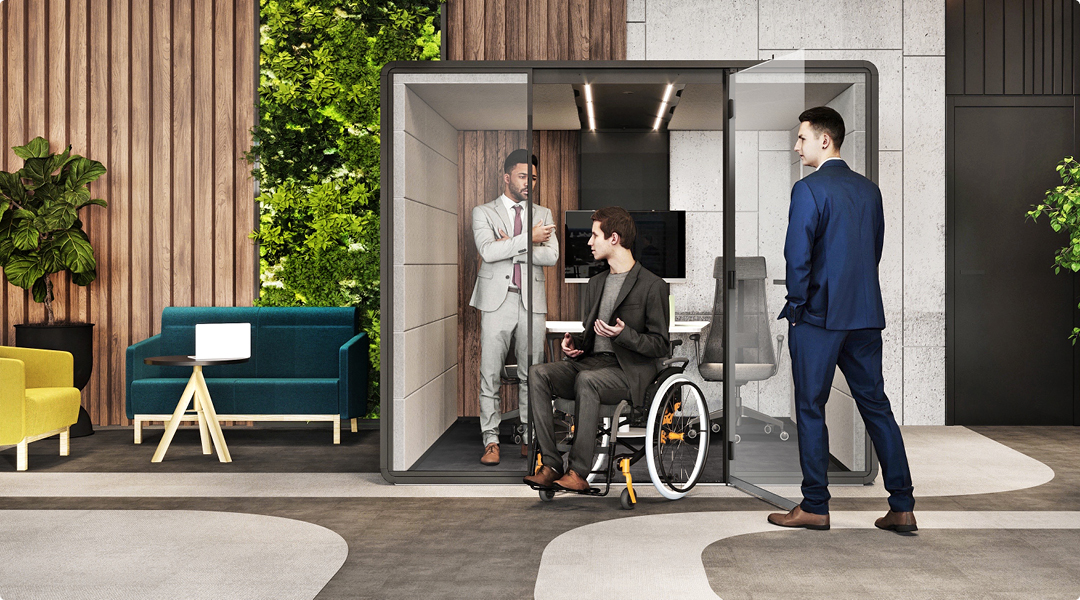
AI can factor in any volume of the finest, most particular of factors. The flow of light throughout a space, both its qualitative and quantitative elements. Or visibility between colleagues that work closely together. Proximity to call spaces. Such factors can be difficult to measure, forget to reconcile against other ones. Artificial intelligence can balance such spatial considerations instantly. Flexible furniture solutions – mobile cubicles and booths like Hushoffice pods (the line includes hushHybrid, hushMeet, hushPhone and hushAccess.L) – are integral parts of this AI-automated office-design puzzle. After all, rollable, adjustable pieces let space planners easily test out different setups, moving furniture pieces at ease. All the while, AI does the heavy lifting of collecting and interpreting data over weeks on how much use a given set-up is getting, discerning the cause of underutilization. Whatever insights AI gleans, a team’s flexible furniture will be ready to relocate, addressing shortcomings without delay
– says Mateusz Barczyk, Senior Brand Manager, Hushoffice.
AI can boost workplace utilization through predictive analysis.
The right inputs let AI create designs that prioritize what matters most, whether energy efficiency or worker concentration. Its ability to understand how employees move and interact within a space, for instance, makes priorities like collaboration or interaction more practically realizable.
Equipped with sensors, the office can become ultimately adaptive.
AI can make the office ultra adaptive – continually evolving in step with changing needs through real-time data analysis and automation. This potential will rely on sensors to collect and interpret information, monitoring occupancy levels, temperature, lighting, to air quality, and beyond.
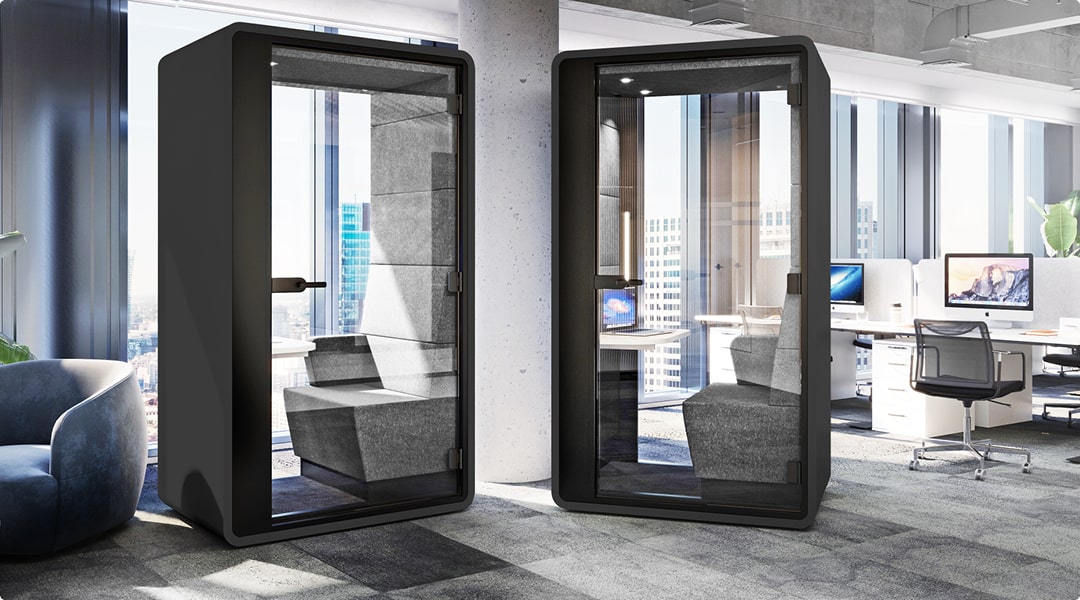
Will AI make workplaces self-learning? Possibly so.
By analyzing enormous amounts of user behavior and space-usage-related data points, an algorithm can spot patterns and trends. Without much manual intervention, it can then make recommendations keen to these patterns and trends, effectively generating design pointers automatically.
AI will be able to relieve architects and designers of tedious work.
Indeed, what might take an architect days of work can be done in seconds by AI. At once, the architect is spared tiresome work while employees are more quickly accommodated by the office’s quicker adjustment.
Properly leveraged, AI will take video conferencing to the next level.
AI audio enhancers already improve speech intelligibility by filtering out background noise. AI can also boost meeting accessibility by transcribing in real-time. There are also many apps available today that correct eye contact, making meeting participants feel more heard and seen.
AI can boost engagement levels during video calls.
AI’s facial recognition technology will increasingly be used to assess people’s interest and engagement levels during virtual meetings. By automatically recording and analyzing meetings, AI will provide companies with clearer insights into what makes meetings effective. That and the reasons behind their success or failure. This technology will also give managers valuable information to identify and support employees who may need attention. Consequently, office design will evolve to include video conference areas equipped with sensors to collect data. This shift will lead to the growing popularity of specialized video call booths such as hushHybrid to optimize these critical touchpoints
– says Mateusz Barczyk, Senior Brand Manager, Hushoffice.
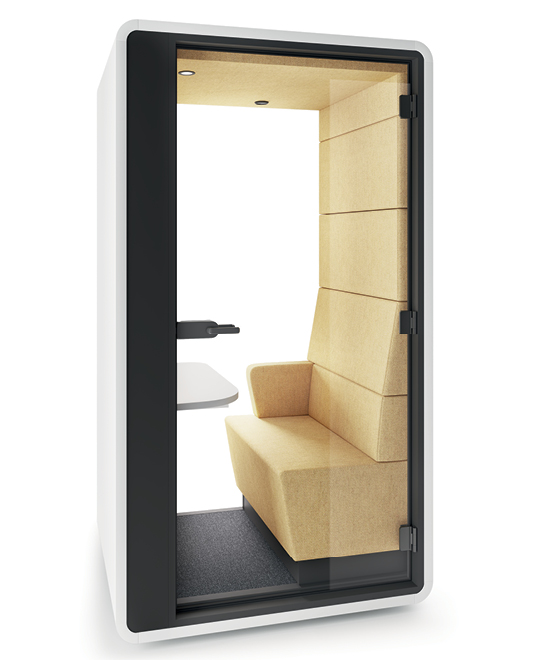
FMs will be able to better visualize and interpret building performance data.
AI sensor networks will give FMs serious insights from wealths of data. The FMs focus may well go beyond maintenance and into strategic planning. In all unique cases, responsiveness will be the end goal greatly aided by AI’s finely painted picture of a building.
By incorporating mechanisms to capture data and insights, FMs will be able to gather valuable information about how the office space is used. More precisely, how a space can be improved for employee effectiveness. And as AI becomes more adept at extracting actionable information from data, there will emerge a natural opportunity to continuously improve the workplace for employees. So the office will be always shaped into the most productive floor plan and atmosphere for the moment. Of course, as the workplace becomes more desirable, meeting employee expectations, occupancy rates may increase, changing the landscape of hybrid work completely
– says Mateusz Barczyk, Senior Brand Manager, Hushoffice.
AI in the workplace – tl;dr
AI is indeed transforming the office design process for architects and designers. It is automating routine tasks. It is offering data-driven insights. And it enables predictive analytics for future trends. It can also be integrated with VR and AR for more immersive design visualization.
For facilities managers, AI’s influence is all about processing data. It will be able to optimize space utilization through the continuous monitoring of occupancy and usage patterns. Properly deployed, AI can also improve energy management by analyzing and adjusting for consumption patterns. Flexible furnishing like mobile pods will be helpful in allowing FMs to make full use of AI’s clear space optimization tips, moment to moment.
The employees’ main touchpoint with AI will be video meetings. For starters, the tech can provide real-time transcriptions and translations. It can improve audio and video quality. And it can gauge participant engagement via facial recognition. Because video meetings are critical in a hybrid world, video call booths like hushHybrid will become standard, allowing for a team to fully leverage AI’s potential to drive human connection moving forward.
AI in the workplace – frequently asked questions
How will AI change the future workplace?
AI will make the workplace more responsive to employee needs. Teams will more and more equip their offices with carefully considered sensor networks. By then giving AI-powered tools the right commands to process each network’s data, new insights into how a workplace is being utilized (and underutilized) will emerge.
Can AI design my office?
Yes, an algorithm can greatly simplify and enlighten the process of laying out a workplace. But it cannot come up with ideas. What experts predict is a future where architects and designers rely on artificial intelligence to reconcile variables such as light flow or proximity to call spaces, indeed. But human creativity will remain essential.
How can AI be used for meetings?
AI can correct eye contact, transcribe in real-time, run facial recognition and emotional analysis to gauge engagement, and improve audio visual quality on video calls.

